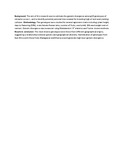| dc.contributor.author | Ngugi, Kahiu | |
| dc.contributor.author | Nabiswa, Alex | |
| dc.contributor.author | Kithinji, Jacob | |
| dc.contributor.author | Muchugi, Alice | |
| dc.date.accessioned | 2015-09-28T11:00:58Z | |
| dc.date.available | 2015-09-28T11:00:58Z | |
| dc.date.issued | 2013 | |
| dc.identifier.citation | Biofuels Volume 4, Issue 3, 2013 | en_US |
| dc.identifier.uri | http://www.tandfonline.com/doi/abs/10.4155/bfs.13.5 | |
| dc.identifier.uri | http://hdl.handle.net/11295/91549 | |
| dc.description.abstract | Background: The aim of this research was to estimate the genetic divergence among 49 genotypes of Jatropha curcas L. and to identify potential parental lines needed for breeding high oil and seed yielding cultivars. Methodology: The genotypes were studied for several agronomic traits including: plant height, days to flowering (50%), male:female flower ratio, number of fruits, seed yield, 100-seed weight and oil content. Genetic divergence was measured using Mahalanobis’ D2 statistics and Tocher cluster methods. Results & conclusion: The most diverse genotypes were those from different geographical origins, suggesting a relationship between genetic and geographical diversity. Hybridization of genotypes from East Africa with those from Madagascar and Mexico would generate high-level genetic divergence. | en_US |
| dc.language.iso | en | en_US |
| dc.publisher | University of Nairobi | en_US |
| dc.title | Genetic divergence in Jatropha curcas L., a potential biofuel crop in Kenya | en_US |
| dc.type | Article | en_US |
| dc.type.material | en | en_US |

